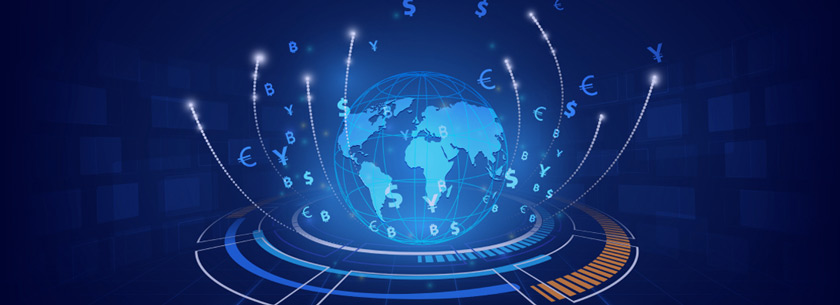
Decentralised finance or DeFi is one of the ways of financial interaction, carried out through specialised apps developed on the basis of the blockchain network.
In addition, this term also means a socio-economic movement aimed at gradually moving away from traditional financial interactions carried out with the help of intermediaries towards creating a simpler, faster and more transparent methodology for interacting with finances. It also includes the desire to lower the possibility of interference in the process of providing financial services by the state. At the moment, such interaction is provided by peer-to-peer decentralised apps — DAPPs.
One of the undoubted advantages of this method of interaction is a more loyal attitude towards users, especially those who for some reason cannot interact with traditional banking systems. In addition, the modular app framework and their interoperability allow users to actively develop and improve decentralised financial networks on their own.
Specific DeFi Benefits
- Refusal from intermediaries. Traditional financial interactions are carried out with the help of banks and regulated through decisions of the court system. Decentralised finances are regulated automatically by predefined algorithms and smart contracts , and are implemented directly between users.
- High resistance to censorship, system errors and complete shutdown. Since the system is based on the blockchain — it is very difficult to make unplanned changes and fake data to abuse its capabilities. In addition, it improves overall network stability.
- High development speed. Modular frameworks allow anyone familiar with programming to create apps for working with DeFi.
- Easy access. Banks, as a rule, refuse services to people with a bad credit history and insufficient income. When interacting within the framework of decentralised finance, it does not matter.
DeFi cons
- Low productivity. The blockchain system is quite slow, so the data processing speed slows down with a large number of network nodes. They work on this problem, but without much result.
- High risk of user error. Since all decisions are made by a particular person, but there are no intermediaries to advise, the chance of an error increases. And since the effect of smart contracts is irreversible, the price of such error is very high.
- Hard to master. Especially at first and compared to traditional methods of financial interaction. So, many users simply have no motivation to master this alternative mechanism.
- Mess and variability. The simplicity of creating apps for DeFi is fraught with the fact that a lot of not very convenient, and sometimes specifically fraudulent, decentralised finance networks have formed. And the user must understand what he/she should use.
DeFi basis — smart contracts
Most apps used to work with decentralised finance are based on a smart contract system. This is a special computer code that runs only under certain conditions, fully automatic and independent. It allows a very large number of parallel processes to be processed simultaneously, which increases the overall power of DeFi networks.
However, this method also has some drawbacks: if the smart contract was not initially worked out properly, the possibilities for its inappropriate use appear. Plus, any program code may contain vulnerabilities and errors, which opens up a huge space for hacker abuse.
Possible applications
- Loans and credits. DeFi provide all comers with an opportunity to connect to the lending system The advantages are obvious: lower rates, because there is no monopoly and thirst for super-profits on the part of the intermediary, the ability to work with cryptocurrencies, a higher transaction speed and no need in checking the credit history. And the use of cryptography methods and automatic smart contracts guarantee loan on-time repayment.
- Insurance and mortgage. There is a fairly effective way to solve the problem of cryptocurrency instability — the so-called stablecoins tied to real financial assets. In fact, they are almost like ordinary money, only their issue is automated, and there is no control by the state. And through these stablecoins, you can interact within the framework of traditional financial methods with a much smaller number of intermediaries, simplified regulation and lower risks. The process of obtaining mortgages and insurance is becoming easier, faster and cheaper.
- Decentralised markets. Or rather, decentralised exchanges that allow settlements exclusively between the wallets of individual users, without the need to keep assets on the exchanges themselves. This reduces the amount of commission and speeds up the process. In addition, transactions are partially automated through smart contracts, which significantly increases their reliability.
- Securities. DeFi can also be used as a way to work with traditional financial instruments. For example, some platforms that work with their own security tokens allow their issuers to issue tokenized securities. In addition, it is possible to work with synthetic assets, forecasting markets, derivatives and other instruments of financial interaction.
DeFi vs Open Banking
Open Banking is a more modern and advanced version of traditional banking systems. It allows third-party financial service providers to interact with user data and finances through special apps. So, for example, there are apps that work several banks and their accounts simultaneously, significantly facilitating the process of transferring money and interacting between individual accounts.
Basically, DeFi allows you to do the same, but without intermediaries, banks and regulating courts. Moreover, it also provides interaction with cryptocurrencies, which are outside the scope of the traditional banking system so far.
Simply put, Open Banking is an official step from traditional financial interactions to decentralised ones.
Conclusion
Decentralised finance is an effective alternative to traditional financial systems, detached from legal and political interventions. Therefore, it is not surprising that DeFi networks and apps are actively developed. Another thing is that this system is still not mainstream and is strongly opposed by traditional financial service providers that dominate most markets. Time only knows whether this situation will change.




